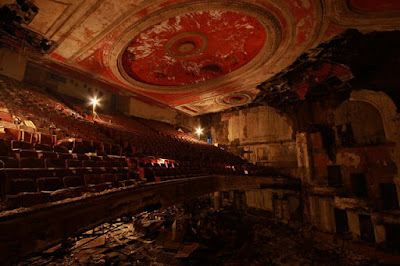The history of the theater goes back to 1886. It was named the H.C. Miner's Newark Theater by theater impresario Henry Clay Miner.
The Newark theater continued to show acts until Miner's death fourteen years later. Miners family would sit on the property for almost two decades before the building was sold to Edward Speigel, who already owned another theater nearby. Not long after the theater changed hands, famed theater designer Thomas Lamb was hired to remodel the theater in "Adam" style.
The fact that Lamb designed this theater is a badge of honor in some ways. He designed nearly 50 theaters in his career in four different countries. His new Newark theater featured many ornate details. A large dome hovered over the center of the auditorium, which now had almost 2000 seats. Inside the dome was a painted zodiac wheel. Carved plasterwork behind the dome depicted noble eagles, with connected swastikas forming a border. The plaster rim was scalloped with the utmost care. In the center and on either side hung large chandeliers.
The plasterwork on the arch around the stage was remarkably detailed. Large corinthian pillars flank both sides, while a large proscenium caps the arch. The new auditorium was a true work of art.
The theater would continue to show vaudeville shows until the early 1930's. The days of vaudeville were coming to an end, however, and in order to save the theater the owners signed a contract with Paramount to begin showing movies. The venue was renamed the "Paramount" theater and the gorgeous auditorium was painted over, covering up the work that Thomas Lamb took such painstaking effort to complete. This action was one of the many reasons attendance began to diminish.
The Newark rebellion and the white flight that ensued made the future unclear for the theater. After a large rise in insurance prices in 1986, the Paramount theater had to close for good. The lobby, which was supplemented a century ago during the first renovation, was split up and used for retail.
In 2012, the RGH development group received a $52 million from the state of New Jersey to help fuel the "Four Corners Millennium Project". This redevelopment calls for a mixed use residential/commercial building to be built on the site of the theater. Plans are to incorporate the facade and marquis into the new building, while demolishing the auditorium. These plans didn't materialize right away though, and the building continued to sit abandoned into the 2020's. In February of 2021 a large snow storm came through and dumped several feet of snow across most of the region. The added weight on the roof was more than the building could take, and a large portion of the auditorium caved in.
Everything beyond the balcony, including the remaining stage ornamentation and half of the dome have crumbled. This all but ensures that the building will never see use as a theater again








Hey, how do you inside the theater?
ReplyDeleteIt's fascinating to learn about Thomas Lamb’s contributions to this historic theatre.
ReplyDelete